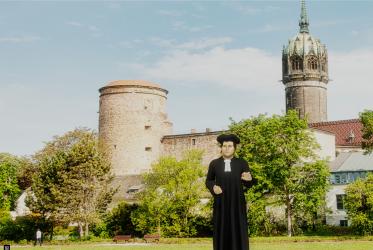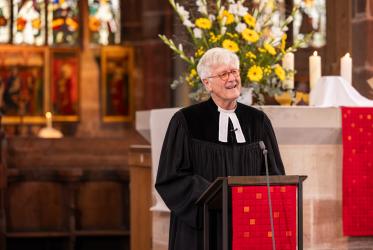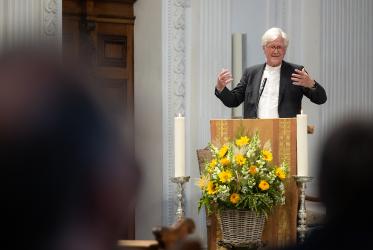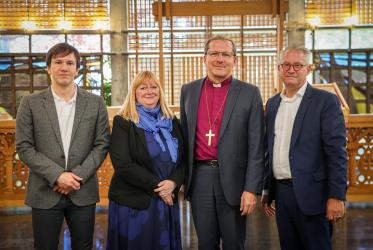By Stephen Brown*
Eastern Germany is the heartland of the Protestant Reformation of Martin Luther, but today is one of the most secularized parts of the world, says German sociologist Monika Wohlrab-Sahr.
“East Germans tend to be stubborn secularists,” she said in a presentation at a recent international consultation on “Reformation – Education – Transformation” in Halle, about 110 miles (175 kilometres) southwest of Berlin, that took place from 18 to 22 May.
“One has to take this secularized state of mind seriously,” said Wohlrab-Sahr, professor of cultural sociology at the University of Leipzig.
Halle itself is at the centre of a region with a rich Reformation tradition. A little over an hour away is Wittenberg, the town where Luther on 31 October 1517 is reputed to have posted his 95 theses denouncing church abuses. Even closer is Eisleben, where Luther was born in 1483 and where he died in 1546.
Nearby is also Leipzig, where Luther defended his ideas in a noted theological disputation in 1519, and where two centuries later the composer Johann Sebastian Bach was organist and cantor at the Lutheran church of St Thomas.
Yet the region is now one of the world’s most non-religious territories, Wohlrab-Sahr noted.
According to a 2012 study, Beliefs about God across Time and Countries, 52 percent of people in eastern Germany said they did not believe in God – the highest percentage for any of the territories surveyed – compared to 18 percent in Great Britain and 10 percent in western Germany.
Wohlrab-Sahr pointed to the period of communist rule from 1949 to 1989 as a major reason for the far-reaching secularization of eastern Germany. The authorities systematically promoted an atheistic “scientific worldview” and sought to marginalize the influence of the churches.
However, the heavily industrialized region of eastern Germany around Halle and Leipzig was also a bastion of secular socialist views from the 19th century onwards, she noted.
Baptism and confirmation are much less popular in eastern than in western Germany. Instead, many young people in the east take part in a secular youth dedication service called Jugendweihe, promoted during the communist period as an alternative to confirmation, and which has outlived the end of communism.
Moreover, the number of secular burials is increasing, Wohlrab-Sahr noted, with 45 percent of eastern Germans opting for an “anonymous burial” where there is no act of remembrance for the deceased person.
“The anonymous burial has become a secular ritual that successfully competes with the sturdiest bastion of the churches, the Christian burial,” she said.
It is a picture that contrasts sharply with the period of East Germany’s “peaceful revolution” of 1989. Churches – as the main institutions not completely integrated into the state apparatus – were full as they opened their doors to East Germans demanding change in the communist-ruled state.
Yet with the opening of the Berlin Wall and then German unification in 1990, the churches were no longer needed as outlets for pent-up frustration and the extent of the lack of belief among eastern Germans became apparent.
“1990 was a huge disappointment for the churches,” Bishop Ilse Junkermann of the Evangelical Church in Central Germany, which includes the Halle region, told a panel discussion during the “Reformation – Education – Transformation” consultation.
Now, she said, “We are on the path to becoming a completely different church.”
Several commentators underlined that the population in eastern Germany is not always hostile to Christianity as such, or even unsympathetic, but simply indifferent.
“Non-religiosity has been inherited over many generations,” explained Professor Michael Domsgen, a theologian at Halle’s Martin Luther University.
Meanwhile, Roman Catholic Deacon Reinhard Feuersträter, a hospital chaplain in Halle, reported how churches in the region are experimenting with a new “celebration for a turning point in life” for young people opting neither for confirmation nor Jugendweihe.
This year, more than 650 young people took part in such celebrations, he said, “organized ecumenically, praise God”.
Still, it was necessary to find a new language to reach young people. “They have to find what I say to be credible,” said Feuersträter. “With my church language I am simply not understood.”
Participants at the Halle consultation said in a concluding statement they wished “to learn from the experiences of our sisters and brothers in this region as they seek to interpret the Reformation tradition in their society today”. Such experiences could provide insights for other places where there is also decreasing identification with religious institutions.
According to Daniel Cyranka, professor of intercultural theology at Halle university, the lack of religiosity in eastern Germany needs to be accepted as the context in which churches there find themselves today, rather than being treated as anomalous.
“Churches must identify and assume duties within a social context that do not serve the church itself but the people and the society,” says Cyranka. “That does not mean that the nonreligious be ascribed a really existing religiosity. Rather it means to communicate with others, even if that involves addressing them in a religious manner.
“And that can be a new experience, for those speaking and those spoken to, whether through prophetic warning, encouragement, or even blessing.”
The consultation on “Reformation – Education – Transformation” was a joint project of Bread for the World, EMW, Faculdades EST São Leopoldo, the Francke Foundations and the Martin Luther University of Halle-Wittenberg in cooperation with the World Council of Churches, the Lutheran World Federation, the World Communion of Reformed Churches, the Evangelical Church in Germany, and other partners.
*Stephen Brown is a freelance journalist and author of several publications on the churches in East Germany.






